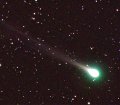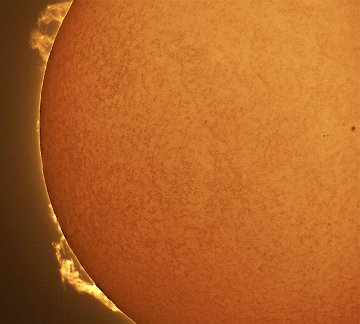|
Science news and information about the Sun-Earth environment. |
|
The Far Side of the Sun Interplanetary Mag. Field
Coronal
Holes
: NOAA Forecasts Solar Flares : Probabilities for a medium-sized (M-class) or a major (X-class) solar flare during the next 24/48 hours are tabulated below. Updated at 2004 Feb 15 2200 UTC
Geomagnetic Storms : Probabilities for significant disturbances in Earth's magnetic field are given for three activity levels: active, minor storm, severe storm Updated at 2004 Feb 15 2200 UTC
High latitudes
|
Hazardous Asteroids
|
| Essential Web Links |
|
NOAA Space Environment Center -- The official U.S. government bureau for real-time monitoring of solar and geophysical events, research in solar-terrestrial physics, and forecasting solar and geophysical disturbances. Atmospheric Optics -- the first place to look for information about sundogs, pillars, rainbows and related phenomena. See also Snow Crystals. Solar and Heliospheric Observatory -- Realtime and archival images of the Sun from SOHO. (European Mirror Site)
Daily Sunspot Summaries -- from the NOAA Space
Environment Center. Recent Solar Events -- a nice summary of current solar conditions from lmsal.com. SOHO Farside Images of the Sun from SWAN and MDI. The Latest SOHO Coronagraph Images -- from the Naval Research Lab The Sun from Earth -- daily images of our star from the Big Bear Solar Observatory List of Potentially Hazardous Asteroids -- from the Harvard Minor Planet Center. Observable Comets -- from the Harvard Minor Planet Center. What is the Interplanetary Magnetic Field? -- A lucid answer from the University of Michigan. See also the Anatomy of Earth's Magnetosphere. Real-time Solar Wind Data -- from NASA's ACE spacecraft. How powerful are solar wind gusts? Read this story from Science@NASA. More Real-time Solar Wind Data -- from the Solar and Heliospheric Observatory Proton Monitor. Aurora Forecast --from the University of Alaska's Geophysical Institute Daily Solar Flare and Sunspot Data -- from the NOAA Space Environment Center. Lists of Coronal Mass Ejections -- from 1998 to 2001 What is an Iridium flare? See also Photographing Satellites by Brian Webb. Vandenberg AFB missile launch schedule. What is an Astronomical Unit, or AU? Mirages: Mirages in Finland; An Introduction to Mirages; NOAA Solar Flare and Sunspot Data: 1999; 2000; 2001; 2002; 2003; Jan-Mar., 2004; Space Audio Streams: (University of Florida) 20 MHz radio emissions from Jupiter: #1, #2, #3, #4; (NASA/Marshall) INSPIRE: #1; (Stan Nelson of Roswell, New Mexico) meteor radar: #1, #2; |
 SPACE WEATHER
SPACE WEATHER




